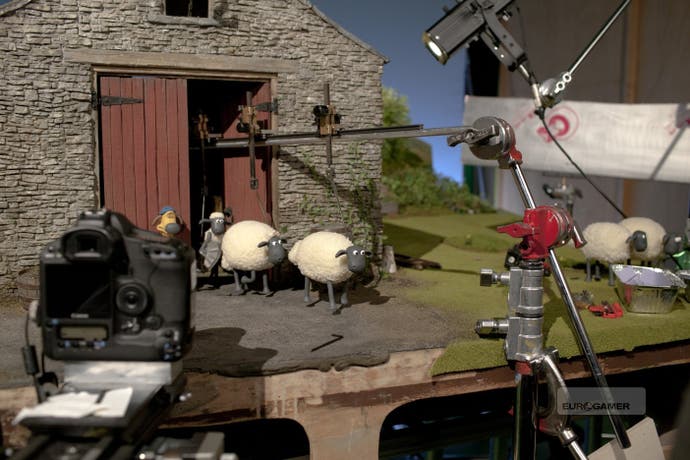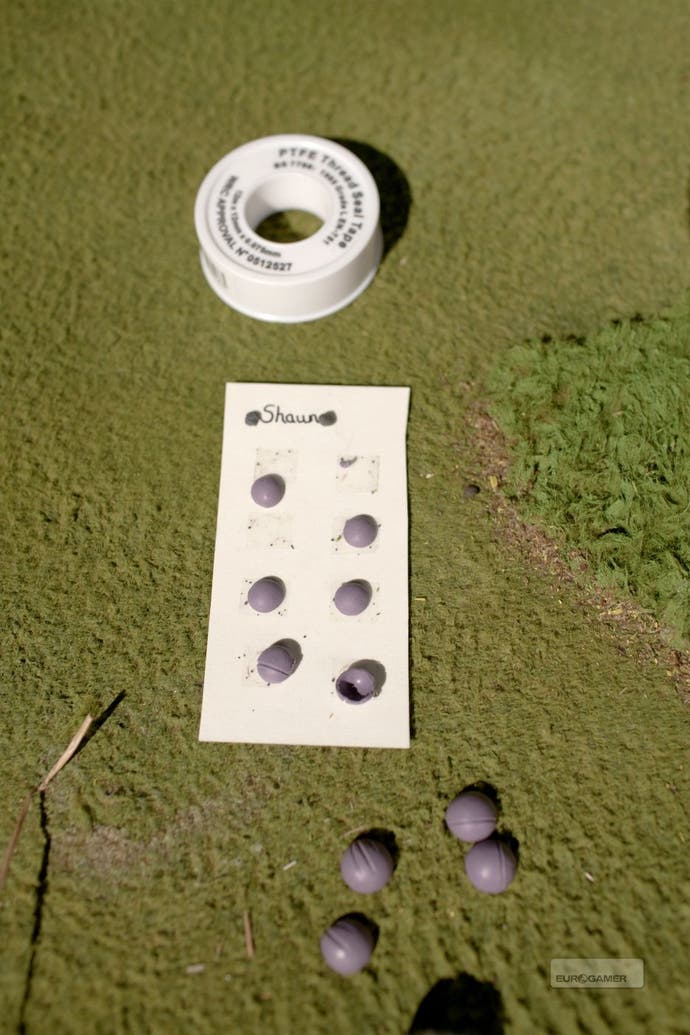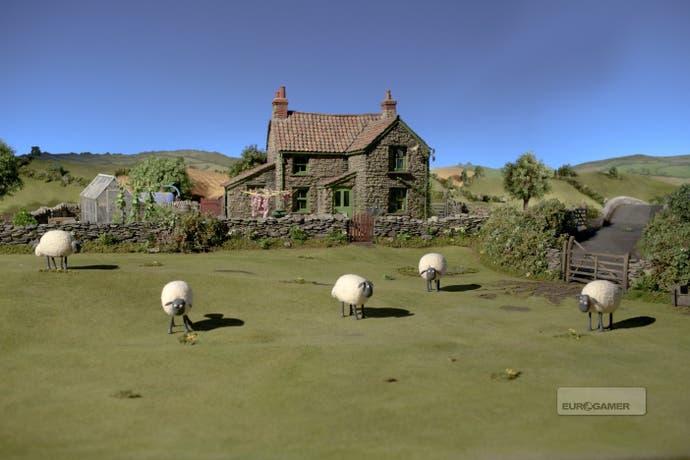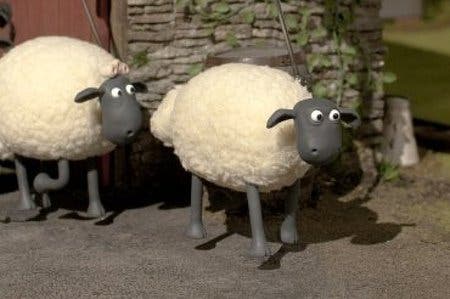Sheep Sharing
We visit Aardman Animations to get the scoop on Shaun's 3DS debut.
"Around here, we're pretty good at making eyelids."
That's what a prop-maker said to me, pretty much out of the blue, while we stood deep within the surprisingly dark and gloomy heart of Aardman Animations' studios, just outside of Bristol.
I'm here to see how work's progressing on the legendary filmmakers' first foray onto the 3DS. Aardman's currently making 15 mini-episodes of its Shaun the Sheep series that will be available for free in March through SpotPass. Up until the whole eyelid business, everything I've seen is pretty much as I had expected it would be.
In the lobby, I've walked past fading posters of The Wrong Trousers and A Grand Day Out, and I'd peeked into glass cabinets displaying BAFTAs, Oscars, and puppets of Chicken Run characters with half their bodies removed and their metal skeletons revealed.
The model-making department upstairs is bright, cluttered, and filled with glue guns, FM radio, and weird boxes with things like "DARWINS - JUST HEADS" written on them. Everybody working here seemed earnest and clever and a little donnish - even the young ones, toting around miniature screwdrivers or wandering about with Plasticine models and cups of tea - and Plasticine models of cups of tea, most likely.

Down on the studio floor, though, it all gets a little eerie. Suddenly, all traces of daylight are blocked out by thick drapes, while an industrious, muttering hush descends. Temporary walls carve the soundstage up into narrow plywood alleyways, and on various delicate sets scattered about the place, I can see animators working by themselves, moving models around miniature farm buildings lit with dozens of halogen bulbs.
The transition between sweet artifice and hectic pragmatism can be surprisingly swift down here: on a barn set, just out of the DSLR's view and inches away from a gaggle of sheep who were held in place with complex rigging, you might spot a box of loose nails, or a roll of duct tape, towering over the cartoon heroes.
I find the prop-makers, meanwhile, at the very centre of all this hushed activity. They are working with dentist's tools, or dentist's tools' near relatives, that they clean every few seconds with baby wipes. It was fascinating to see these people going about their jobs. It always is when arcane expertise is involved. To me, most of the little scalpels and picks they were wielding looked alike, but to them they're clearly precision implements designed for extremely specific tasks. Not this one, I need the other one. Where's it got to?
Prop-makers get up to some weird stuff, it turns out. They make eyelids - and teeth - on an industrial scale, for example, and, when I visit, they were busy dismantling the stars of Shaun the Sheep in some surprisingly ghoulish ways. 15 episodes, even at a mere one-minute running time each, is quite an undertaking for a studio, particularly when a simple nine-second shot can take three days to film.
To speed things along, Aardman tends to chop its world-famous characters into little pieces, so animators can swap things in and out efficiently. One of the prop-makers bends over a little tray with 12 spaces in it, each one holding the lower jaw of the series' farmer, contorted into a slightly different expression. Another one cleans the legs of one of Shaun's flock. They'd gotten quite grubby during their last filming session, apparently. Luckily, they can be removed in seconds, scrubbed down, and replaced. Children must never, ever see this place.

Aardman's been operating this way for years, of course, but working with Nintendo has still had quite an impact on this most English of film companies. In the spare props area, alongside tiny rubbery Wellington boots, little stepladders and barbecue sets, you'll see dinky 3DS's, perfectly cloned, right down to their d-pads and shoulder triggers, while the animators working nearby are busy filming scenes with a new camera process that allows them to output the final episodes in stereoscopic 3D.
This technique is rather cool, actually. In an editing room upstairs, I ask David Sproxton, who founded Aardman alongside Peter Lord, how it all works. Then I get confused, and he had to explain it to me again, using much shorter words. "As with all 3D, it comes back to the brain's ability to put displaced images together," Sproxton says. "We shoot right eye content and left eye content. Conventional 3D cameras have two lenses, both a little distance apart. Our character models are too small for that - we couldn't get two lenses that close - so we actually take a shot, move the camera a few millimetres, and then take another. In post production, that gets put back together as a single 3D frame."
Sproxton later admits, with the kind of embarrassed gurning expression that Wallace would be proud of, that he doesn't actually have a 3DS yet - but he does seem keen to get hold of one, at least. On a broader scale, I'd love to tell you that the collaboration here has been close and intense: that Sproxton's geniuses had met with Miyamoto's geniuses, and everyone had swapped ideas, forged new projects, and emerged the richer.
That doesn't seem to be the case. Nintendo can be rather hands on with some of its partners, but it clearly sees Aardman as an equal, and has left the Shaun team to it. "Nintendo approached us before they launched the 3DS last year," explained Sproxton. "They'd seen our characters and they wanted content for the handheld. They asked what our most international brand was, and that's Shaun the Sheep.
"It was quite a smart move, really," he laughs. "I think they realised we've been in 200 countries worldwide, it's silent comedy so it travels, and it's slapstick so it works well in little snippets. This is exactly the kind of thing we're best at doing. We started thinking about the series, and then we sent them, I think, 15 little paragraphs of episode ideas. I think we did rough storyboards, and they said fine. We sent them other storyboards, and they liked them too. In the end, they just said, "You know what you're doing, make it work, and, if you can, see if you can get a 3D element into the gags." Then they just let us get on with it."
Still, even if we aren't going to get a Plasticine Mario any time soon, the films themselves are typically lovely. Filled with wonderful detailing and rendered in decent if rather starkly layered, 3D, they're smart gag reels: a set-up, a little messing around, and then a pay-off. In one, a duck sheds its feathers for a life-drawing class. In another, Shaun plays Mario on his 3DS and then jumps and bottom-bounces his way around the farmyard.
It looks effortless which means, of course, that it's been a tricky process. "It took me by surprise, really, because it proved quite difficult," says Richard Goleszowski, an animation legend whose CV, alongside Shaun the Sheep, includes Peter Gabriel's Sledgehammer video (ask your dads), Robbie the Reindeer (ask your kids), and Rex the Runt (ask Peter Gabriel).

"We sat down with storyboarders and we kept coming up with all these great ideas that sounded funny," he says. "Then, when we timed them out, they came in at about 30 seconds. We discovered that we were writing sketches, essentially. We were trying to get away from adding real stories, because that's always a lot more difficult.
"After a while, though, we couldn't avoid it and we had to start structuring the episodes like stories. Then they started coming out as two minutes or three minutes. We just had to keep trying, and you gradually get into a one-minute frame of mind, where you're telling a funny little story, but you aren't getting lost within it."
Eventually, the team hit on a clever conceit that helped out quite a lot: if the Shaun the Sheep TV series is about the working week on a farm, the mini-episodes cover what the gang gets up to in their time off.
Weird eyelid production aside, I leave the studio feeling that Aardman and Nintendo make for a pretty natural sort of union. Both companies have forged names for themselves creating wonderful, charming products that appeal to people all around the world. Both have a warm, and often surprisingly sophisticated, sense of humour to them. Most of all, though, both make things that children can enjoy without feeling patronised. Shaun's going to be right at home on the 3DS.
Shaun the Sheep's new 3DS adventures will be available via SpotPass, for free, starting on 7th March.









